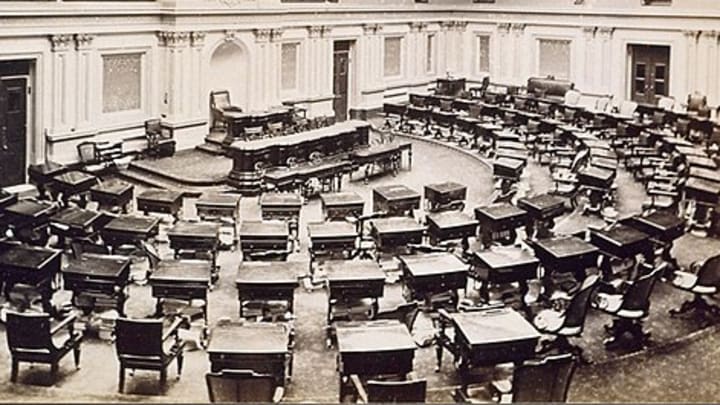It may seem reminiscent of elementary school to plead and barter to sit at a certain desk, but plenty of U.S. senators would disagree. Forty-eight of the current Senate desks have been around since 1819, ordered after British troops destroyed the Capitol five years prior. The historic moments that happened at these desks—and the Senate VIPs who sat behind them—mean that some of the desks have taken on lives of their own. In recent decades, senators have decided to leave their own marks by inscribing their names on the inside of the desk drawers. Here are five examples of the famous furniture.
1. The Daniel Webster Desk
The desk once used by Sen. Daniel Webster stands out from the others because it lacks any extra amenities—if you can call a writing box and an extra drawer “amenities.” When the useful additions were placed on all of the other Senate desks between 1820 and 1840, Webster refused, finding the renovations a waste of taxpayer money. Though his successors have had the option of adding the extra pieces, they have all declined, keeping with tradition.
Since the 1930s, it has been tradition for the senior senator from New Hampshire to sit in the same desk Webster once claimed as his own—and it has been official since 1974. That’s when the Senate passed Resolution 469 declaring that the desk would, “at the request of the senior senator from the state of New Hampshire, be assigned to such senator for use in carrying out his or her senatorial duties during that senator’s term of office.” Sen. Jeanne Shaheen occupies the desk now.
2. The Henry Clay Desk
Even the venerable Abe Lincoln looked up to Sen. Henry Clay of Kentucky, calling him "my ideal of a great man." So, it's not surprising that other senators from the Bluegrass State would want to soak in some of his essence. In 1999, the Senate passed Resolution 89, which ensured that Clay's old desk would always be assigned to the senior senator from Kentucky. Sen. Mitch McConnell sits there at the moment.
3. The Jefferson Davis Desk
Before he became president of the Confederate States of America, Jefferson Davis was a senator from Mississippi. When a Union regiment from Massachusetts camped in the Senate chamber in 1861, overzealous soldiers sought out Davis’s desk and attacked it with bayonets, intent on its destruction. Doorkeeper Isaac Bassett heard the commotion, ran in, and demanded to know what was going on. “We are cutting that damned traitor’s desk to pieces,” they told him. Bassett informed the posse that the desk belonged to the government, not Jefferson Davis. It was enough to stop them, but there’s still an inlay patch on the side of the desk from the resulting repairs.
In 1995, Senate Resolution 161 declared Davis’s desk would go to the senior senator from Mississippi. It’s currently occupied by Sen. Roger Wicker.
4. The John C. Calhoun Desk
Andrew Jackson may not have thought much of South Carolina Senator John C. Calhoun—he once said one of his few regrets in life was not hanging Calhoun when he had the chance—but senators still clamor to sit where Calhoun once did.
When Sen. Ernest F. Hollings of South Carolina discovered that Sen. Russell B. Long of Louisiana was occupying Calhoun’s former desk, he politely requested the seat. Long declined, informing Hollings that his father Huey P. Long and mother Rose McConnell Long had both claimed the desk before him. When Long retired, however, he bequeathed the Calhoun desk to Hollings—and when Hollings left in 2004, he passed it on to Sen. Lindsey Graham.
5. The Strom Thurmond Filibuster Desk
Some desks are more infamous than famous. It seems no one wants to occupy the place where scandalized presidents Warren G. Harding and Richard Nixon both sat, for example. And then there’s the Strom Thurmond desk. The South Carolina senator proudly inscribed the desk after his long-winded filibuster “achievement” against the Civil Rights Act of 1957: “spoke 24 hrs. 18 min. from this desk in 1957.”
Sen. Chuck Grassley of Iowa sits there now.
A version of this story ran in 2016; it has been updated for 2022.
